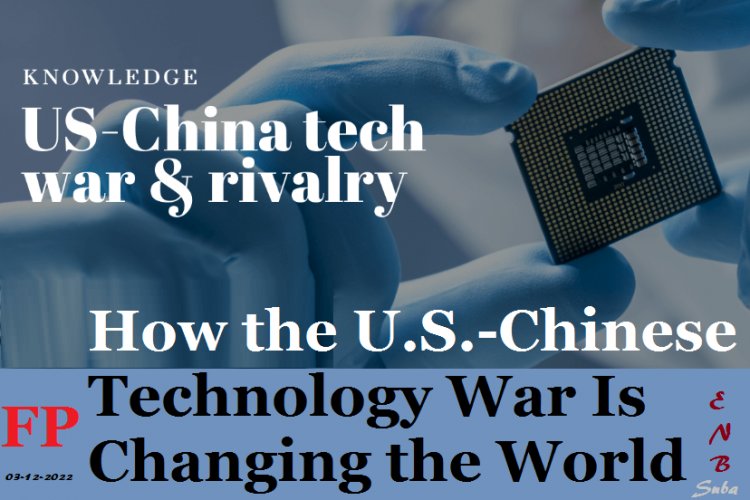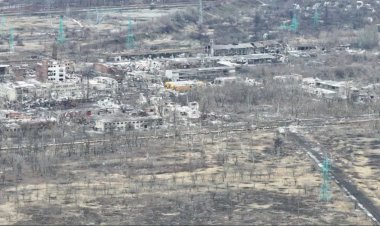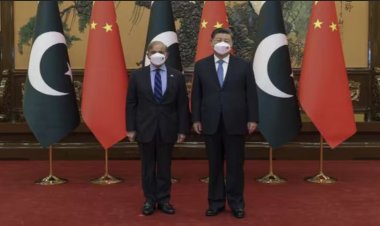How the U.S.-Chinese Technology War Is Changing the World
Washington’s crackdown on technology access is creating a new kind of global conflict.

In the summer of 2020, massive wildfires erupted in California and Oregon. Forest fires are a yearly occurrence in the region. Yet amid devastation and chaos, the thousands of firefighters battling the flames quickly noticed that something was different from other years. Controlled burning, a crucial tool to prevent wildfires, had not taken place during the spring. Something else was amiss:
There were no drones available to monitor how quickly the flames were spreading. If firefighters had known why there had been no controlled burns and why drones were missing, they would probably have been surprised. It had nothing to do with forests, environmental policies, or perennial budget cuts. It was all about China.
The previous year, the Trump administration had ordered U.S. government agencies to stop using more than 800 drones that previously helped to monitor fires and to conduct controlled burns across the country. The drones worked perfectly well, but they were made by DJI, a Chinese company. Using unmanned aircraft from DJI is nothing special: The firm supplies more than 70 percent of the world’s civilian drones. However, the administration worried that the drones might covertly send sensitive information to China, allowing Beijing to see exactly what the drones could see.
DJI had vigorously denied these claims and taken steps to relocate production to the United States. Staff from the U.S. Interior Department had warned that halting controlled burning would likely result in catastrophic wildfires. Yet the administration had chosen to ignore these warnings and to go even further with its China-proofing strategy: Washington also halted the acquisition of 17 high-tech systems, called Ignis, which help to start controlled fires. The technology was American. Several years earlier, the U.S. government had added Ignis to a top list of “Made in America” innovations. However, there was a catch: The Ignis systems include Chinese-made components. For the administration, this was too much of a risk to take.
With drones grounded and Ignis systems missing, the U.S. Office of Wildland Fire was able to carry out only a quarter of the controlled-burning operations that it had arranged to undertake in 2020.
The backup plan would have been to use aircraft manned by firefighters, but this option was quickly abandoned: It imperiled human lives when there was a risk-free alternative.
The lack of drones was a tangible illustration of the ripple effects of the U.S.-China conflict. It came with catastrophic consequences. It is unlikely that using drones would have prevented the fires, which were due to an unusual combination of strong winds and extreme heat. However, perhaps it could have helped to lower the death toll (nearly 40 people died) and to reduce the scope of the damage (which reached $19 billion in California alone). Was mitigation of unsubstantiated risks that China may use the drones to spy on U.S. soil worth such a high price? For Washington, the answer was apparently a clear yes.
Washington’s concerns around China’s technological rise—and the industrial espionage and cybertheft that go with it—date back to the early 2000s. They came to the fore in 2018, when the U.S. trade representative issued a lengthy report summarizing China’s perceived offenses against the United States. The document highlighted Washington’s realization that the Chinese economy is not market-driven, but fully state-led. According to the U.S. government, China’s economic strategy focuses on attracting foreign firms, stealing their technology, and indigenizing it before forcing the companies out of the Chinese market. In the view of U.S. policymakers, this process involves only a few, well-documented steps.
First, the Chinese government forces global companies that want to gain access to China’s market to form joint ventures with Chinese firms. These local companies have one single objective: siphoning the technological secrets of their foreign counterparts. This is a well-known issue; as the U.S. Office of the National Counterintelligence Executive put it, “Chinese actors are the world’s most active and persistent perpetrators of economic espionage.” (To be fair, the United States is probably not far behind.) Alternatively, China may also force Western firms to sell their know-how to their Chinese partners at ridiculously low prices.
Once Beijing has gathered the technology it is looking for, Chinese companies replicate it. This is the famous moment when foreign businesses realize that a factory closely resembling their own has just opened down the road. Strangely, the Chinese plant happens to manufacture exact replicas of the Western products. Washington believes that Beijing eventually plans to kick foreign companies out of China. This makes sense, in theory: Once Chinese companies have gotten hold of foreign technology, Beijing may see little reason to let competing foreign firms remain in its domestic market.
These unfair practices are widely acknowledged, but they form only one aspect of U.S. concerns toward China. In recent years, the U.S. government has also become increasingly worried that letting Chinese technological companies operate on U.S. soil or having U.S. government agencies use Chinese-made technology puts national security at risk. This was the reasoning behind the grounding of the controlled-burning drones on the West Coast. The issue is far from limited to drones, however. The argument goes that all of China’s high-tech companies have ties to the Chinese state and may be compelled to secretly gather data on their Western consumers.
On paper, these concerns appear valid. Although there are no public records of such an occurrence, China’s national security law may force Chinese companies that operate in the United States to collect information on American citizens or businesses and to send these data back to Beijing. Chinese firms have no choice but to cooperate with Beijing; according to China’s regulations, the companies have no right to appeal such requests. Many U.S. firms already take these issues seriously. Technological supplies to Google and Facebook, for instance, have to be China-proof.
From this perspective, Chinese-made cellphone towers installed near government buildings, such as federal offices or military bases, pose an especially acute threat. This is the crux of the debate around Beijing’s participation to the global rollout of 5G telecommunications networks. Defense hawks believe that China could use the infrastructure to spy on sensitive installations. China’s backers are quick to point out that these concerns are both theoretical and unsubstantiated. However, there are precedents: On two separate occasions, China was accused of spying on the Ethiopian headquarters of the African Union. Beijing and the Chinese companies that are suspected of having been involved have denied the accusations, which the African Union has also—albeit inexplicably—downplayed.
The U.S. security establishment’s worst-case scenario looks even more worrying. Some experts fear that installing Chinese-made telecommunications equipment on U.S. soil may enable Beijing to pull the plug on America’s phone or Internet networks. Most analysts believe that this is not really feasible. At any rate, this sounds unlikely: China’s growth would tank if the U.S. economy crashed. If China took such an extreme step, Beijing’s long-term ability to convince countries to install Chinese telecommunications equipment would also suffer. However, if the United States and China became embroiled in a direct military conflict, for instance over Taiwan, Beijing would have nothing to lose.
The U.S. president has committed to rapid decoupling, whatever the consequences.
Nowadays, the bipartisan view in Washington’s corridors of power is that China is rolling out a revamped version of economic imperialism, just like Great Britain in the 19th century or Japan after World War II. To retain its role as the world’s sole superpower, Washington believes that it has to stop Beijing in its tracks. Some Americans go as far as seeing the U.S.-China clash as a generational one, on a par with conflicts against the former Soviet Union or Islamist terror. The reality may be less dramatic. The conflict between the United States and China is one for economic dominance between an incumbent economic superpower and its rising challenger.
In this economic war, the United States is unsurprisingly keen to put all forms of economic coercion to good use. The Trump administration imposed tariffs on $360 billion of U.S. imports from China; President Joe Biden has made it clear he is not lifting these. The United States has also sanctioned Chinese individuals linked to human-rights abuses against both the Uyghur minority in Xinjiang and pro-democracy protesters in Hong Kong. In the financial sphere, U.S. lawmakers are pondering whether to delist more than $1 trillion worth of shares of Chinese companies on U.S. stock exchanges. Congress is also considering barring the Thrift Savings Plan, which manages the pensions of millions of federal government employees, from investing in Chinese companies.
The Chinese economy, however, has grown far too big for Washington to sanction Beijing with its usual toolkit. The United States has probably explored all the potential trade tools—mainly tariffs—that it can use against China. Financial sanctions appear highly unlikely; targeting the world’s second-largest economy with financial sanctions would almost certainly backfire. The United States needs something else to advance its interests against China. Washington has therefore focused its efforts on the technology sector.
In 2016, the Chinese leadership announced that it planned to spend $150 billion over 10 years to develop a Chinese semiconductor industry. The U.S.-China conflict had not started in earnest by then, but Beijing’s announcement raised alarm bells across the U.S. defense establishment. Experts warned that China’s plan to beef up its presence in the semiconductor sector put U.S. national security at risk: In a few decades, Chinese firms could become able to manufacture microchips more advanced than the United States’. As a result, China’s missiles, lasers, or air defense systems could become the most sophisticated in the world.
Semiconductors are the Achilles’ heel of the Chinese economy. Beijing buys more than $300 billion of foreign-made semiconductors every year, making computer chips China’s largest import, far above oil. This reflects the fact that Chinese factories import 85 percent of the microchips they need to build electronic goods.34 Most of these semiconductors are manufactured using U.S. technology. For Washington, this makes export controls a seemingly ideal tool to deprive Beijing of U.S. innovation and know-how. Such restrictions function in a similar fashion to financial sanctions: They seek to curb adversaries’ access to U.S.-made staples—the greenback for financial sanctions or computer chip technology for export controls—that have become so crucial that few countries can do without them.
Washington knows that it has a massive trump card to play in the semiconductor sector: Virtually every microchip around the world has some link to the United States, be it because it was designed with U.S.-made software, produced using U.S.-made equipment, or inspected with U.S.-made tools. This is not surprising: The United States is the birthplace of the semiconductor industry. The sector was born in the 1950s to meet the growing tech needs of the U.S. military as it started to confront the former Soviet Union. Around 70 years later, U.S. microchip firms have a market capitalization of around $1 trillion. Simply put, the United States dominates the field.
U.S. firms manufacture only around 10 percent of the computer chips sold across the world. The world’s leading microchip foundries (as semiconductor assembly lines are called) are located in Asia, mainly in Taiwan and South Korea. However, a handful of U.S. companies control all of the higher, upstream echelons of the supply chain. Given the United States’ dominance over the microchip sector, Washington knows that measures curbing China’s access to U.S. semiconductor technology have every chance to deal a blow to Beijing’s technological ambitions.
In 2018, Congress started to put this strategy into practice, quietly adopting a flurry of regulations meant to cut China’s access to U.S. know-how. In May 2019, the Trump administration started to impose export controls on Huawei, China’s telecommunications giant, sending shockwaves through the global technology sector. Washington took these restrictions a step further in May 2020, when the administration announced that it was barring all microchip manufacturers from forging chips for Huawei, anywhere across the world, if they used U.S. technology. Three months later, the Commerce Department further tightened the rules to ban all microchip sales to Huawei. In the remainder of the year, the administration broadened the restrictions to target dozens of other Chinese firms; these included SMIC, China’s largest maker of microchips.
These measures appeared severe at the time, but they were only the first steps. In October, the Biden administration dealt an even more severe blow to China’s technological sector: Instead of targeting only high-profile Chinese firms, Washington clamped down on all exports of advanced microchips and semiconductor-making tools to China. U.S. citizens were also warned that without explicit (and unlikely) U.S. government approval, they are breaking U.S. law if they choose to work for Chinese technology firms.
In many ways, these measures closely resemble financial sanctions. The difference is that instead of targeting global companies using the dollar, Washington is applying coercive measures to firms using U.S. technology, no matter whether these firms are American or foreign. Like financial sanctions, these export regulations seek to force countries and companies to choose sides between the United States and the sanctioned country—in this case China. The United States is betting that the world’s largest microchip producers, such as South Korea’s Samsung or Taiwan’s MediaTek and TSMC, will side with it and stop working with Chinese companies. Alternatively, these foreign firms could maintain ties to China, but this would come at a high price: Using U.S. technology to design or manufacture microchips for Chinese firms has become impossible. Continuing to serve the Chinese market now entails rebuilding entire, U.S.-proof manufacturing lines for Chinese customers at a cost of several billion dollars.
The global ripple effects of export controls against Chinese technological firms have proved colossal, probably even more than the Commerce Department expected. Huawei had to stop production at a number of its facilities, as many of them relied on U.S.-made equipment. Faced with high levels of uncertainty, SMIC slashed spending and investment plans. Outside China, the managers of microchip foundries frantically started to check whether their equipment used U.S. technology. If this was the case, working with dozens of firms from China, the world’s largest importer of semiconductors, had become illegal.
In some rare instances, the production lines of global tech firms did not rely on U.S. technology. In theory, this shielded these companies from U.S. measures. However, Washington intended to see to it that all Western companies ditched their contracts with Beijing—a lesson the Netherlands’ ASML, which builds machines capable of carving out microchips, learned the hard way. The U.S. administration pressed the Dutch government hard to ensure that it would forbid ASML from working with Chinese companies. The Netherlands eventually gave in to U.S. pressure and revoked ASML’s export license to China.
For Beijing, this was a sure sign of problems to come: The Dutch firm is the only company in the world that masters the extreme ultraviolet technology that SMIC needs to manufacture highly advanced chips. For the Dutch company, this development was bad news, too. The equipment cost more than $20 billion to develop, and the fast-growing Chinese market was one of the most promising. ASML’s CEO later hinted that the company was looking at making its supply chains fully U.S.-proof.
Export controls against Huawei were not meant to have a domestic impact, but they also had ripple effects on U.S. soil. Rural cellphone and Internet providers had long understood that they were in trouble. The cheap Huawei gear they had bought to connect remote and sparsely populated places to the Internet abruptly stopped receiving crucial software updates or replacement parts from U.S. firms. This was a death sentence: Without these updates and spare parts, Huawei cellphone towers and Internet networks will, over time, simply stop working.
On the other side of the Pacific, Beijing knows that Washington’s new export measures will pose a host of new problems to address. For the Chinese leadership, semiconductors are especially important in two areas: the manufacturing of cellphones and the roll-out of 5G networks on Chinese soil. The United States does not seem intent on curbing China’s ability to manufacture cheap, basic cellphones, as these do not pose a security threat to the United States; the White House has extended export licenses to a number of U.S. and foreign companies so they can continue to deal with Huawei for such unsophisticated products.
However, Washington appears keen to apply export controls to their fullest extent when it comes to highly advanced, ultrasmall chips. For China, this will be a major headache in the coming years.
High-tech microchips are a crucial component of much-touted 5G telecommunications networks. Washington’s willingness to restrict Beijing’s access to advanced semiconductors will likely hamper China’s development of 5G infrastructure. The Chinese leadership will probably be able to prioritize the roll-out of 5G in a few high-profile cities and regions. However, the rest of the country will probably have to wait for longer than expected to get access to the innovations that fifth-generation networks enable, such as self-driven vehicles or smart electric grids.
Such ripple effects, both in China and the United States, are likely to be only the tip of the iceberg. The consequences of export controls restricting China’s access to U.S. technology will be witnessed only over several decades. Innovation tends to come with long-term industrial investments that involve meticulously arranged supply chains and manufacturing processes. U.S. export controls will alter these plans.
The world’s leading microchip manufacturers, including Taiwan’s TSMC (which controls around half of the global production capacity) and South Korea’s Samsung (which specializes in the most advanced microchips), are already redesigning their global supply chains with U.S. export controls in mind. TSMC plans to open a giant, $12 billion foundry in Arizona by 2024; the U.S.-subsidized plant will probably only serve the U.S. market, while other TSMC factories will continue to do business with Chinese firms. Samsung’s latest projects also reflect this new reality: The South Korean firm plans to build two foundries in the coming years, one in Texas for $17 billion and another one in Xian, in central China, for $15 billion.
Even if U.S.-China tensions were to recede, which appears highly unlikely, the long-term nature of such massive investment programs means that the effects of export controls will prove both long-lasting and hard to unwind. The Sino-American conflict over technology will take place across several decades, probably well beyond 2050. Export controls look set to form the bulk of Washington’s arsenal to defend U.S. interests, especially in the technological sector. The measures illustrate the growing shift toward an environment where technological leadership is the main driver of political influence and economic power, as well as a crucial determinant of military might.
- Agathe Demarais
Disclaimer: This page expresses the views of the author. We publish it on this site for discussion
– Senthalam news section












